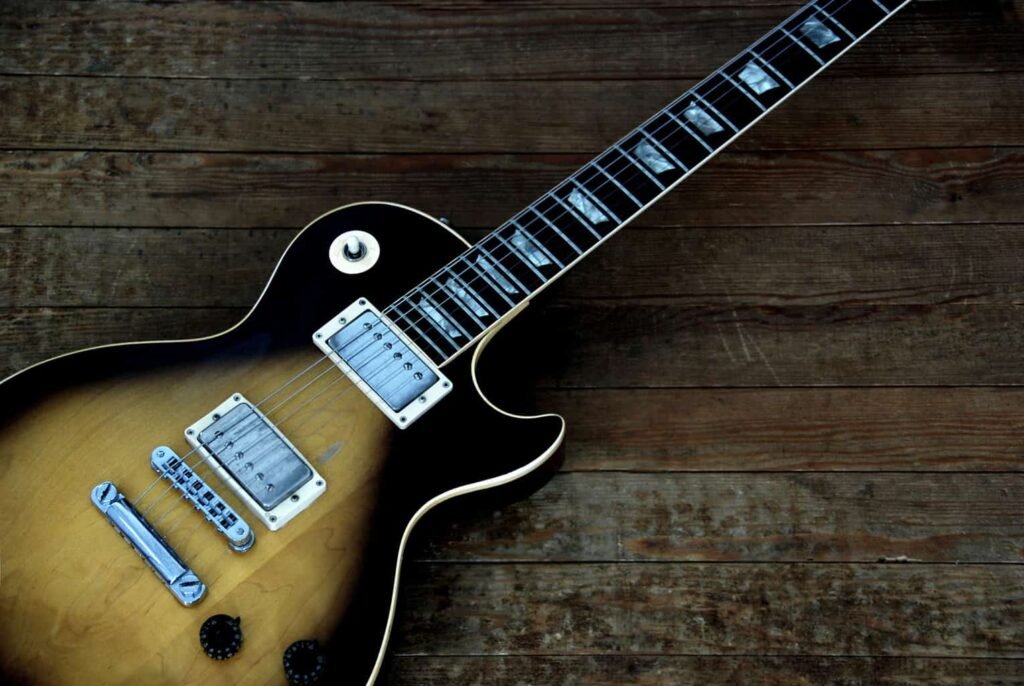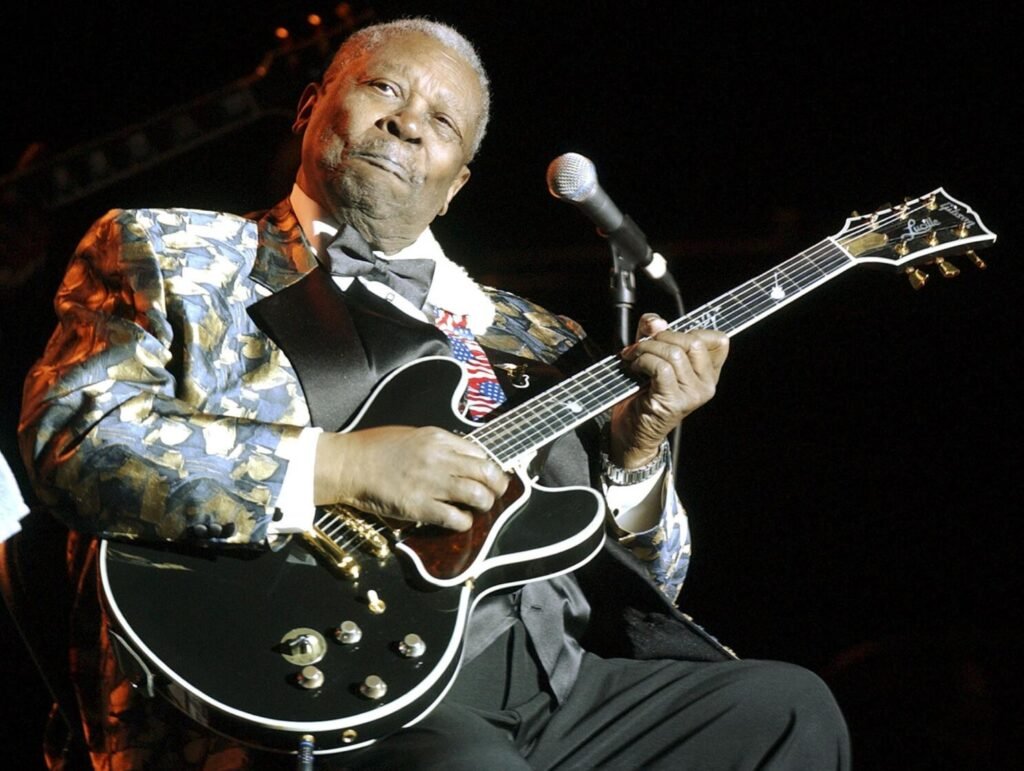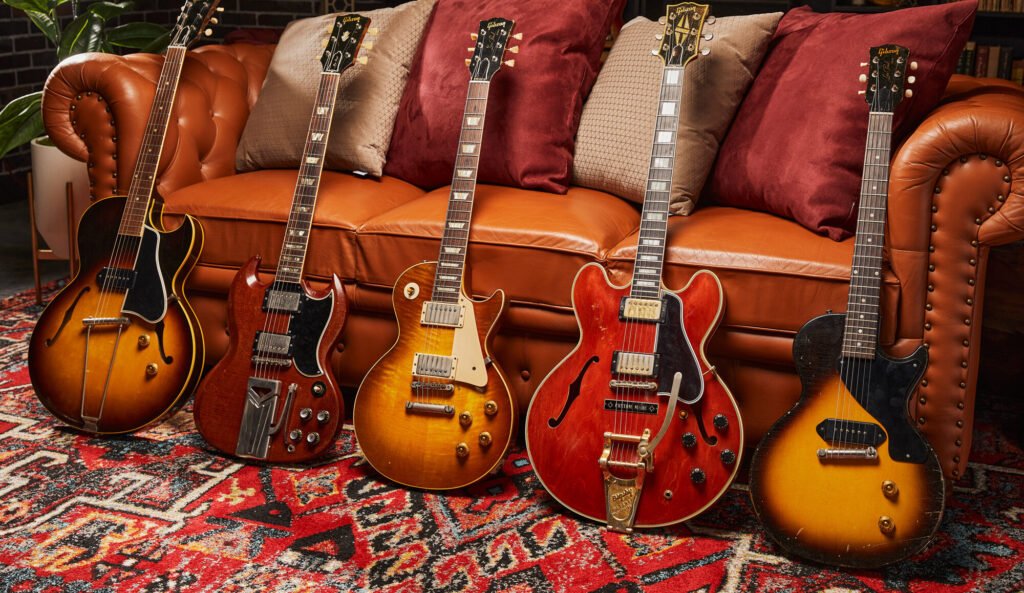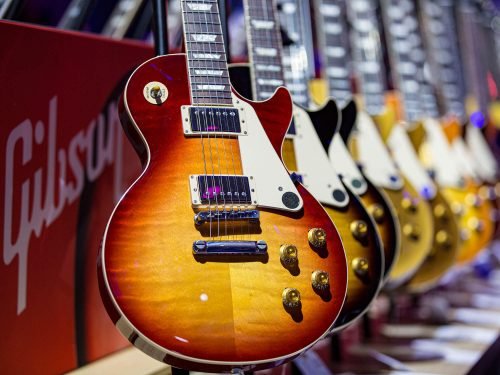In the pantheon of musical instrument manufacturers, Gibson stands as a titan. Founded in 1902 in Kalamazoo, Michigan, and eventually relocating to Nashville, Tennessee, Gibson has been at the forefront of guitar innovation and production for over a century. Known globally for its commitment to quality, the Gibson name is synonymous with iconic design and sonic excellence. This legacy is built on a foundation of pioneering craftsmanship and a relentless pursuit of perfection, characteristics that have cemented Gibson’s status as a pivotal player in the music industry.
The impact of Gibson guitars can be traced through the hands of countless musicians who have turned to the brand’s distinctive models to articulate their artistic visions across various genres. From rock and roll to jazz, blues to punk, Gibson guitars have not just been present; they’ve often led the charge in musical revolutions.
This article aims to delve into the historical significance of Gibson’s legendary models: the Les Paul, the SG, and the ES-335. Each of these guitars has not only helped define the sound of a generation but has also inspired musicians and influenced music production through the ages. We will explore how these models came to be, their evolution over the decades, and their enduring impact on music and culture worldwide.
Gibson’s Innovation and Craftsmanship

The origins of Gibson can be traced back to a small workshop in Kalamazoo, Michigan, where founder Orville Gibson began making mandolins in the late 19th century. His innovative designs, which departed from traditional European styles, quickly garnered attention and acclaim. By 1902, the Gibson Mandolin-Guitar Mfg. Co., Ltd. was established, signaling the birth of a company that would grow to be a cornerstone of the American music industry. Gibson’s early reputation was built on the back of these mandolins, renowned for their superior sound and build quality, setting a precedent for the standards the company would uphold across all its instruments.
Technological Innovations
Gibson’s entry into the guitar market was marked by continuous innovation. The 1930s saw the introduction of the first “archtop” guitars with f-holes, like the Gibson L-5, which became a standard for jazz musicians. These guitars featured carved tops influenced by violin design, enhancing both their aesthetic and acoustic qualities. This period also witnessed Gibson pioneering the development of electric guitars in response to the growing demand for louder instruments in band settings.
The introduction of the ES-150 in 1936—a model widely regarded as the first commercially successful electric guitar—marked a significant milestone. It featured a bar pickup that came to be known as the “Charlie Christian” pickup, named after the jazz guitarist who popularized it. This innovation was a game-changer, dramatically influencing the development of guitar music by allowing players to experiment with new sounds and styles that were not possible with acoustic guitars alone.
Post World War II
In the post-World War II era, Gibson continued to innovate, particularly under the guidance of legendary president Ted McCarty in the 1950s and 1960s. McCarty’s tenure was characterized by significant technological advancements and the introduction of models that would become synonymous with the Gibson name. The development of the Tune-o-matic bridge and the humbucking pickup were revolutionary. The former provided players with the ability to precisely adjust the intonation and action of their guitars, while the latter reduced noise and provided a richer, more powerful sound. These advancements not only improved the functionality and reliability of guitars but also expanded their musical possibilities.
It was these innovations that set the stage for the creation of Gibson’s most iconic models. Each model reflected a blend of artistic design, innovative technology, and meticulous craftsmanship, ensuring that Gibson guitars were not only instruments but also art pieces in their own right. The foundation laid by these early innovations was crucial for the development and success of the legendary models like the Les Paul, SG, and ES-335, each of which would go on to shape the music landscape in its unique way.
The Les Paul: A Monument in Rock

The inception of the Gibson Les Paul guitar in the early 1950s marked a pivotal moment in the history of rock music. This iconic model was the result of a collaboration between Gibson and the renowned guitarist, inventor, and recording pioneer Les Paul. Les Paul had been experimenting with solid body electric guitars since the 1940s, aiming to create an instrument that could offer sustained sound, minimal feedback, and enhanced playability. Gibson, initially skeptical, saw potential in Les Paul’s innovations as competitors like Fender began popularizing their own solid-body designs.
Introduced in 1952, the Gibson Les Paul was crafted to meet the demands of the evolving music scene. Les Paul’s direct involvement in the design process ensured that the guitar would bear features conducive to both recording and live performances, qualities he deeply valued. This collaboration not only resulted in a highly functional and revolutionary instrument but also significantly boosted Gibson’s image and market share in the burgeoning world of rock ‘n’ roll.
Characteristics and Sound
The Les Paul is distinguished by several key features that contribute to its unique sound and aesthetic appeal. The guitar’s body is typically made from solid mahogany, providing a warm and resonant tone, with a maple top often added for a brighter, more articulate sound. This combination of woods contributes to the rich, full-bodied tonal characteristics that the Les Paul is famous for.
One of the most significant developments in the Les Paul’s design was the introduction of the humbucking pickup in 1957. Designed by Gibson engineer Seth Lover, humbuckers were intended to cancel out the hum and electrical interference that plagued earlier single-coil pickups. These pickups also provided a thicker, louder, and smoother sound, which became a defining characteristic of the Les Paul and a favorite among rock guitarists for its ability to drive amplifiers into overdrive and sustain long notes.
Iconic Players and Performances
The Les Paul quickly became the guitar of choice for many of rock music’s most influential guitarists. Jimmy Page, known for his complex arrangements and monumental solos with Led Zeppelin, frequently used a Les Paul to achieve his powerful and dynamic sound. His use of the guitar on tracks like “Whole Lotta Love” and “Stairway to Heaven” showcased the instrument’s versatility and capability to capture a wide array of tones, from clean and melodious to raw and gritty.
Another seminal figure in the history of the Les Paul is Slash, whose work with Guns N’ Roses in the late 1980s and early 1990s epitomized the guitar’s sound in rock music. The opening riff of “Sweet Child o’ Mine,” played on a Les Paul, is emblematic of the guitar’s rich harmonic overtones and sustained decay, elements that have helped define the rock genre.
The SG: Redefining Versatility

(Photo by Ross Marino/Rock Negatives)
The Gibson SG (Solid Guitar) was introduced in 1961 as a radical redesign of the Les Paul, which by the late 1950s had not achieved the commercial success Gibson had hoped for. The redesign was primarily motivated by the need to compete with other lighter, more accessible models that were gaining popularity. Initially marketed as a new version of the Les Paul, this model featured a thinner, flat-topped mahogany body and a distinctive double cutaway, providing easier access to the higher frets.
However, Les Paul himself did not favor the new design and requested his name be removed from it. As a result, the guitar was rebranded as the “SG,” which quickly became a standalone model in Gibson’s lineup. This decision marked a significant turning point, both in terms of design and marketing, setting the stage for the SG to develop its own legacy distinct from the shadow of the Les Paul.
Sound and Playability
The SG’s design contributed greatly to its distinct sound and playability. Its lighter body made from solid mahogany contributes to its rich resonance and sustain, while the twin cutaways allow for unparalleled access to the upper frets, a feature particularly appreciated by lead guitarists. The SG’s neck profile, which is generally thinner than that of the Les Paul, offers players faster and more agile handling, making it suitable for rapid and intricate guitar solos.
Equipped typically with dual humbucking pickups, like its cousin the Les Paul, the SG can deliver a wide range of tones from warm depths to piercing highs, suitable for heavy riffs and sharp solos alike. The overall sound is slightly brighter and sharper than the Les Paul, due to its thinner body and the absence of a maple cap.
Diverse Usage Across Genres
The SG’s versatility has made it a favorite across various musical genres, not just limited to rock. Angus Young of AC/DC is perhaps one of the most iconic SG players, whose energetic performances and powerful guitar riffs have become synonymous with the instrument. His aggressive playing style showcases the SG’s ability to handle high-energy rock music and its effective sustain and rich harmonic tones.
Beyond rock, the SG has been embraced by musicians in blues and jazz as well. Artists like Derek Trucks and Frank Zappa have exploited the SG’s expressive tonal range to produce sounds that are integral to their innovative musical styles. In jazz, the SG’s clean and articulate sound complements complex chords and melodic lines, demonstrating its adaptability and broad appeal.
The ES-335: The Hybrid Pioneer

The Gibson ES-335 stands as a monumental innovation in the world of electric guitars. Launched in 1958, it was the first guitar of its kind to offer a solution to a common issue faced by many guitarists of the era: how to harness the tonal richness of a hollow body with the feedback resistance and sustain of a solid body. The ES-335 achieved this with its pioneering semi-hollow body design, which features a solid maple wood block running through the center of its otherwise hollow body. This design was a significant breakthrough, providing guitarists with the best of both worlds and opening up new possibilities in sound and performance.
Unique Features and Sound Quality
The semi-hollow body of the ES-335 not only helped in reducing feedback, a frequent problem with fully hollow electric guitars, but also enriched the instrument’s tone with a warm, open resonance that is distinctly different from both solid and fully hollow body guitars. This quality makes the ES-335 versatile in its application, capable of producing the warmth of a jazz box and the clarity and sustain characteristic of solid body guitars.
Additionally, the ES-335 is equipped with two humbucking pickups, which add to its robust sound profile, enhancing its versatility. The combination of its unique body construction and these pickups allows the ES-335 to deliver a wide range of tones—from mellow, deep jazz lines to sharp, biting rock riffs. The inclusion of a tune-o-matic bridge and a stop bar tailpiece further refines its sustain and intonation, making it an incredibly responsive instrument that appeals to technically demanding players.
Cross-Genre Appeal
The ES-335’s adaptability has made it a beloved instrument across various musical genres. In the world of blues, legendary guitarist B.B. King famously wielded his ES-335 variant, known affectionately as “Lucille,” to produce his iconic, soul-stirring sounds. King’s use of the ES-335 highlighted its expressive capacity and its ability to convey the emotional depth of the blues.
In the jazz domain, the ES-335 has been a favorite among many guitarists for its rich tonal quality and flexible handling. Jazz guitarists appreciate the instrument’s ability to articulate complex chords cleanly and its responsiveness in fast-paced soloing. Meanwhile, in the rockabilly scene, artists have leveraged the ES-335’s bright, twangy character, which complements the energetic and rhythmic style of this genre.
Cultural Impact and Legacy

The introduction of Gibson’s iconic models, the Les Paul, SG, and ES-335, brought about transformative changes in both studio recordings and live performances. Each of these guitars contributed unique qualities that enabled musicians to explore new sonic territories and techniques, significantly influencing the evolution of music production.
In the studio, the Les Paul’s rich, sustained tones made it a favored choice for producing thick, layered guitar tracks that became a staple in rock music production. Its ability to maintain clarity even when heavily distorted provided a new level of dynamic expression in recordings. Similarly, the SG’s lighter weight and accessible fretboard encouraged guitarists to perform more complex and rapid passages, contributing to more technically demanding production styles.
The ES-335’s semi-hollow body offered a unique sound that was invaluable for studio work, where its versatility across genres made it a preferred instrument for sessions that demanded a broad range of tones. From clean, jazzy articulations to gritty blues and rockabilly twangs, the ES-335 could cover an expansive sonic palette without the need for multiple guitars.
Live performances also saw a shift with the adoption of these Gibson models. The Les Paul and SG’s robust build and powerful output allowed guitarists to push their amplifiers harder, achieving louder volumes without losing tonal integrity. This capability was crucial as rock concerts grew in size and scope, requiring instruments that could project across larger venues. The ES-335, meanwhile, with its feedback-resistant design, became a reliable choice for live jazz and blues musicians who needed both the acoustic properties of hollow bodies and the volume capabilities of solid bodies.
Enduring Legacy in Modern Music
The legacy of Gibson’s iconic guitars continues to resonate in the modern music scene. These instruments have not only stood the test of time but have also remained at the forefront of musical innovation. Many contemporary artists, spanning various genres from indie rock to R&B, still favor these models for their distinctive sounds and the historical weight they carry.
The Les Paul, for instance, continues to be a symbol of rock music’s golden era, yet it is equally revered in today’s diverse music landscape. Modern guitarists like St. Vincent, who has her signature model, use it to create sounds that blend old-school rock with contemporary electronic music. The SG has found renewed interest among younger musicians in the punk and metal scenes, where its aggressive tone and sleek playability are highly valued.
The ES-335 remains a favorite in both traditional and modern jazz contexts. Its ability to provide a clean, resonant tone suits the sophisticated harmonic frameworks of jazz fusion and neo-soul genres, proving its adaptability and enduring appeal. Additionally, its rich, full-bodied sound continues to be a go-to for recording artists looking to capture the vintage vibes of the past while crafting the sounds of the future.
Gibson’s iconic guitars have not only shaped the music of their times but have also become ingrained in the cultural fabric of music. Their influence extends beyond the notes they produce, touching on aspects of style, technique, and sonic exploration. As they continue to be used by innovative musicians, these models perpetuate their legacy, proving that their impact on music is as profound today as it ever was.
